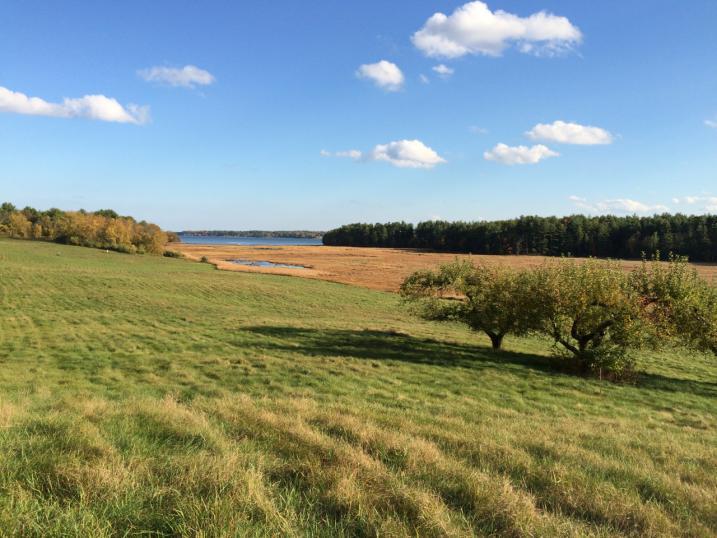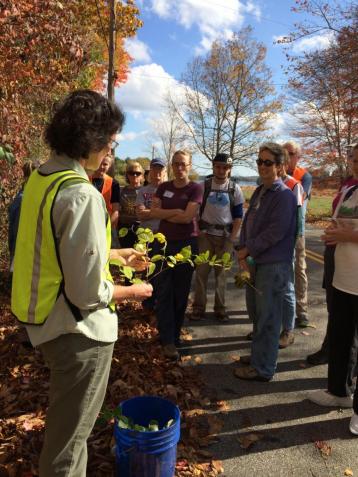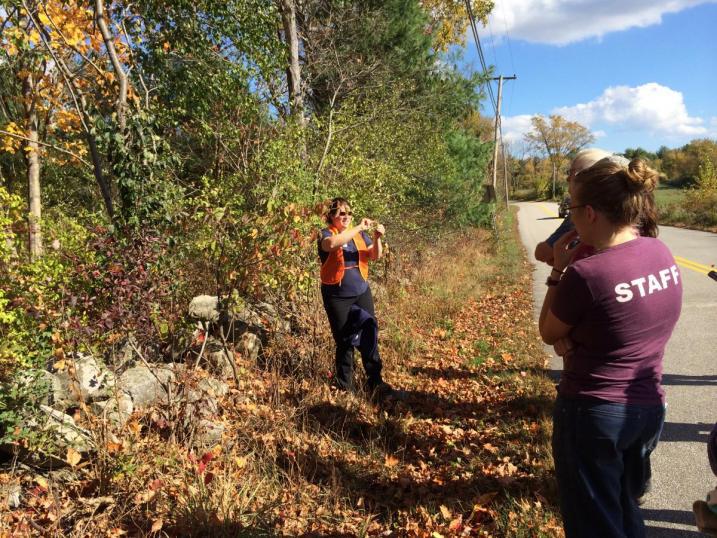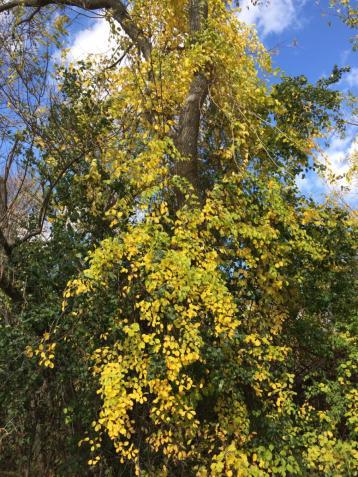Looking on the Bright Side: How to Turn An Invasives Problem into an Opportunity

I spent my last sunny afternoon of Indian summer in the Seacoast on the edge of the Great Bay in Newmarket, NH. It was the perfect day for a lover of the outdoors to get outside and spend time in nature. As a native of the Seacoast (but on the Maine-side in Kittery), I felt excited to get a taste of the salt air and the milder weather that this region brings. What I didn’t know was that I was about to learn something that would blow my mind.

Ellen Snyder and Emma Carcagno from The Stewardship Network: New England lead the last workshop of the year for the Conservation Commission Field Training Series, a partnership between UNH Cooperative Extension and the NH Association of Conservation Commissions. The topic was “How to Lead an Invasive Plant Workday.” Before we got into the nitty-gritty of how to run a workday and get some hands-on practice removing plants, we had to walk a short stretch of road to get to our project site, a trailhead for the Sweet Trail, which runs through the region. This is when I saw the thing that shocked me.
Ellen stopped us on our walk and began to collect a variety of plants: oriental bittersweet, Japanese barberry, autumn olive, burning bush, common and glossy buckthorns, multiflora rose, garlic mustard, and honeysuckles were added to a 5 gallon bucket! ALL within a short distance of each other. ALL invasive species. We soon had enough cuts of plants to make a beautiful, although a bit terrifying, bouquet.
I grew up a stone's throw from this particular place and never knew about any of these plants. I also had no idea until now how pervasive some invasive species were in certain areas of New Hampshire. I’ve been working in the conservation field for almost 4 years now, and while I’ve worked on trails and conservation land here and around the country, I never had the opportunity to work on any invasive species removal projects.
What I learned on that beautiful afternoon was that if you want to see what your community is going to look like someday, you should take stroll through the Seacoast and look for these invasive species. If they aren’t in your community yet, they will be soon enough.
Interspersed with the invasive species were a variety of native shrubs and trees, all of which are great sources of food for native birds and insects. Emma pointed out the native shrubs and what benefits each holds.
I was joined by a large group of conservation commissioners, master gardeners, professionals working in the invasives field, and other enthusiastic volunteers. We marveled at the plants themselves and learned a great deal about their ecology in a short amount of time. But then we were struck with the question that brought us together in the first place: what can we DO about the growing number of invasive plants in New Hampshire and New England? How can we possibly tackle this enormous task at hand?
It turns out one of the ways almost anyone can start to do this is by getting outside and doing some manual removal. Conservation Commissions or other groups responsible for conservation lands that contain invasive shrubs and plants (and chances are they do!) can hold an invasive plant workday. A workday is a great opportunity to remove problem plants and slow their spread, and offers an opportunity for local community members to get out on public land, gain familiarity and connection with a natural space, and accomplish something that feels good.
Ellen and Emma had a full work day set up for us to demonstrate some techniques, including some hand-pulling of invasive plants. Here are a few tips that I learned for hosting an effective workday:
- Reach out to non-conservation groups for help. Working with groups like boy scouts, girl scouts, businesses, college service groups or other community groups can ensure you have a set number of volunteers to accomplish your project and can already have a sense of camaraderie and friendship to work well together.
- Take a few minutes to explain the big picture of your project; how it will benefit the environment and/or community.
- Make it fun!! Don’t be afraid to include i.d. quizzes, a social aspect, or use humor. Your volunteers will be more productive when happy and will also be more likely to work with you again if they had a good time.
- Set reasonable goals and reward success. Even if you have a long-term project, set small goals for your workday so your volunteers can leave feeling like they accomplished something. Take photos of your progress, tally up your accomplishments, and thank the group with these statistics at the end of your day.
You can read more tips for working with volunteers here, or download a checklist for running a workday.
Invasives are expanding here in New Hampshire and New England. Many of us know a lot about these plants, but so many others just aren’t aware (even folks like me!). We can accomplish so much by engaging volunteers in workdays. Most importantly, I think, through the simple act of bringing volunteers together on a project we can provide the opportunity for learning, stewardship, and connection to the public lands that our communities depend upon and value.


